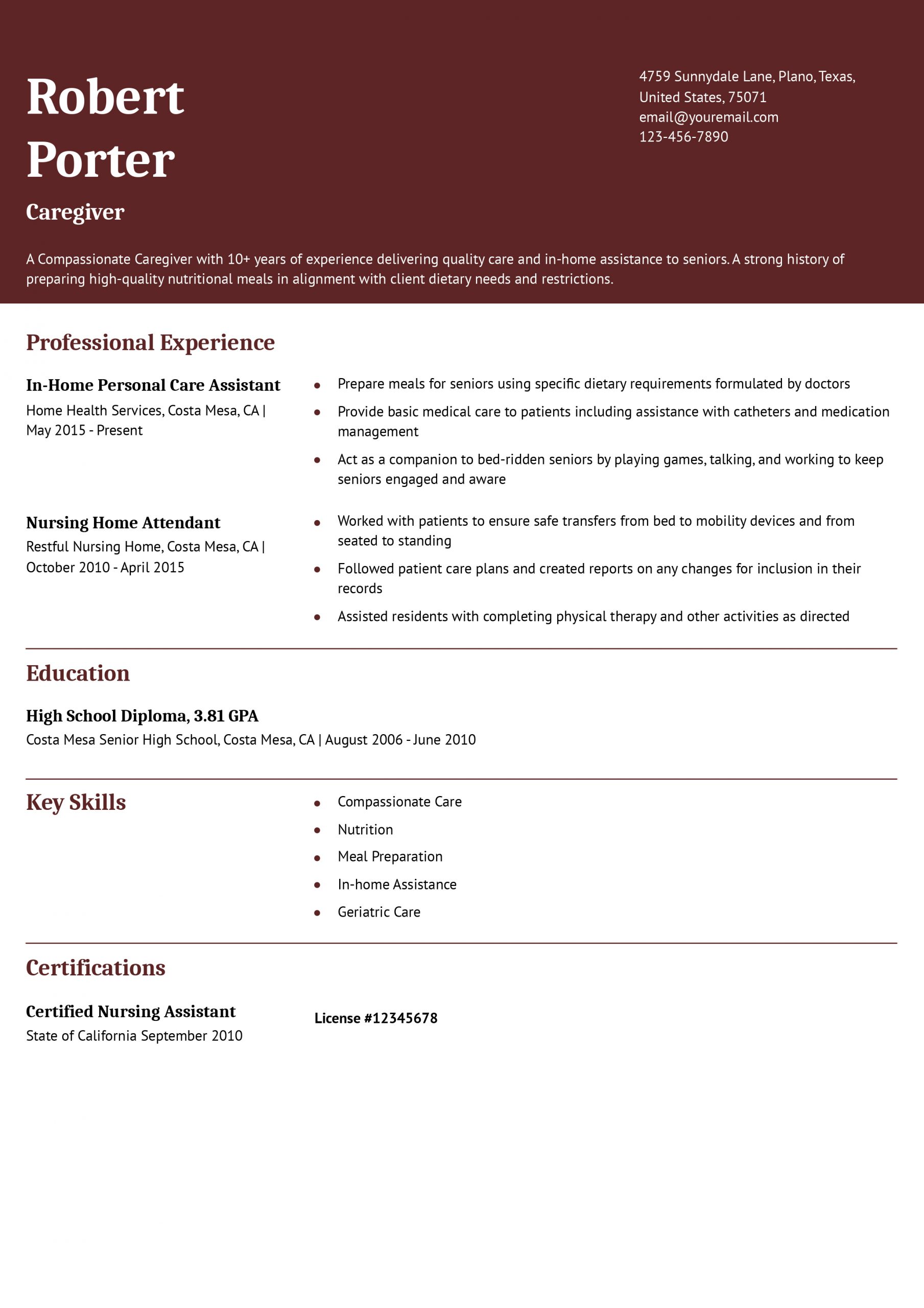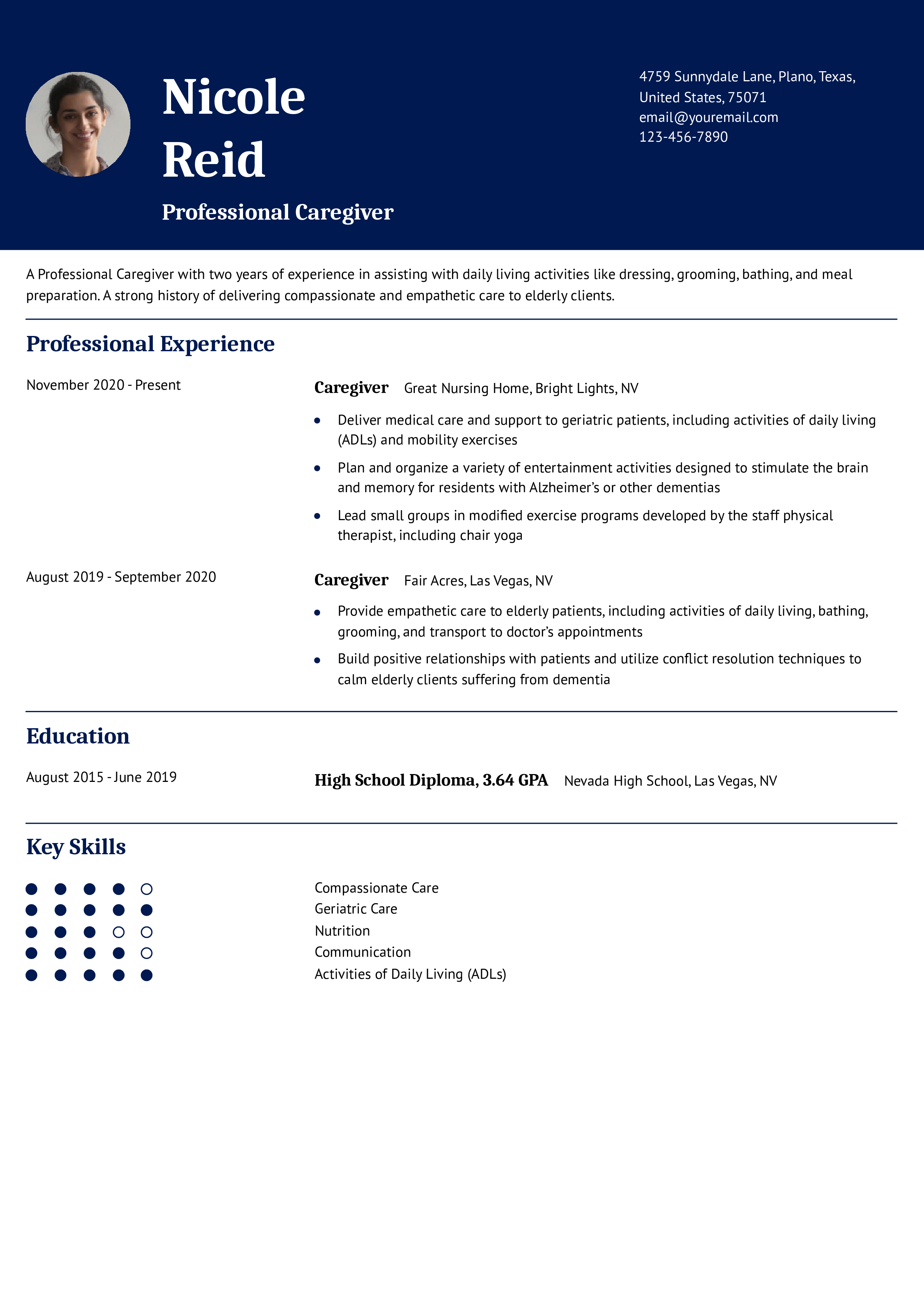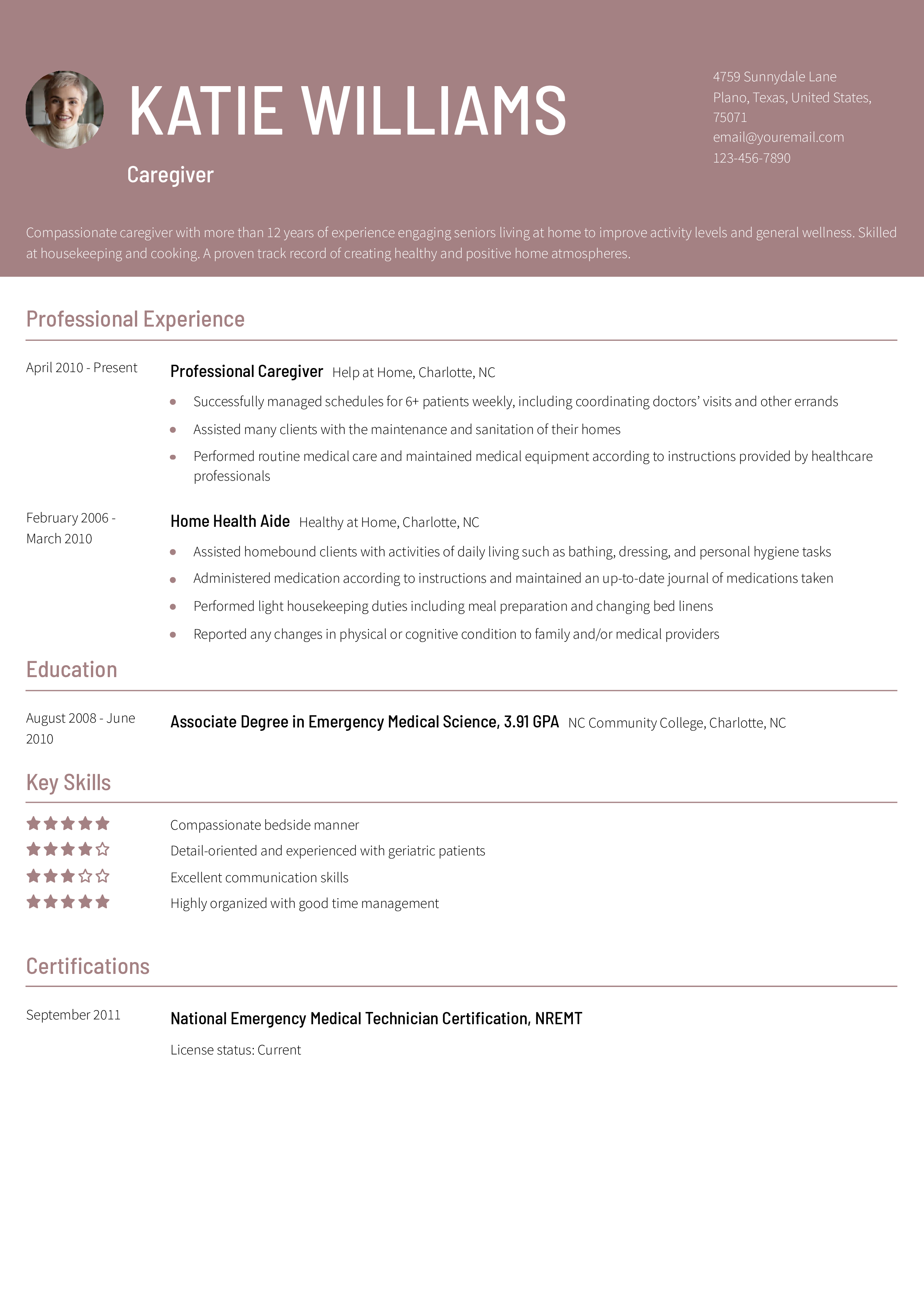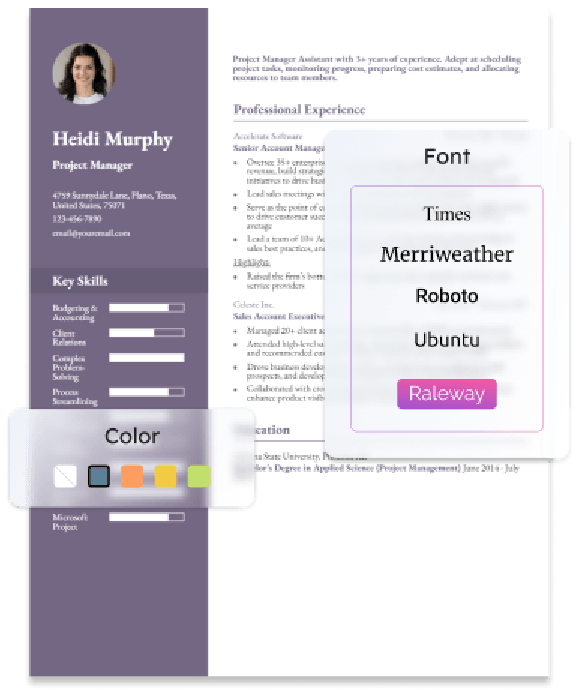Caregiver Resume Templates and Examples (Download in App)
- Entry-Level
- Mid-Career
- Senior-Level
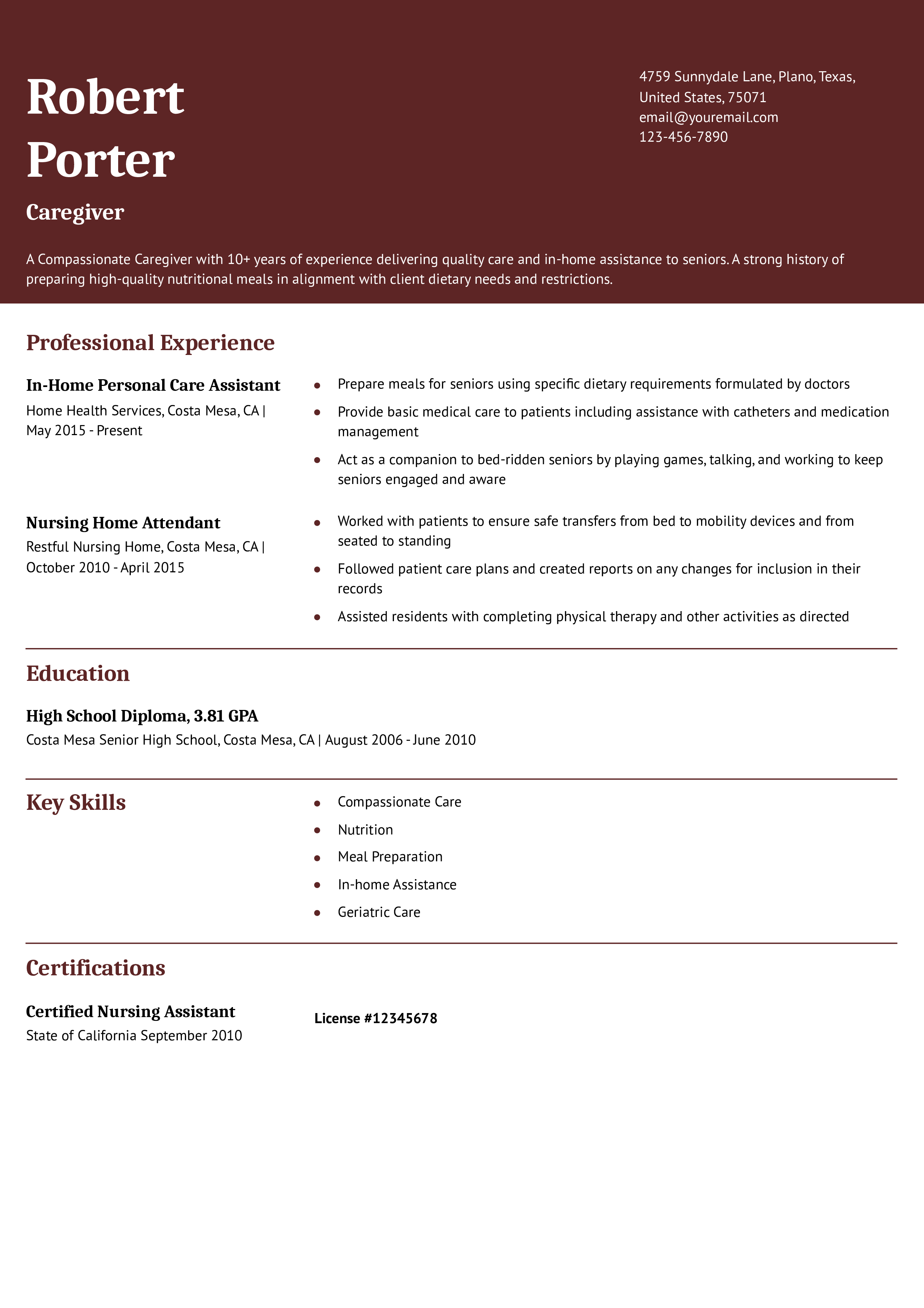
Most Popular Caregiver Resumes
Caregiver Resume Example
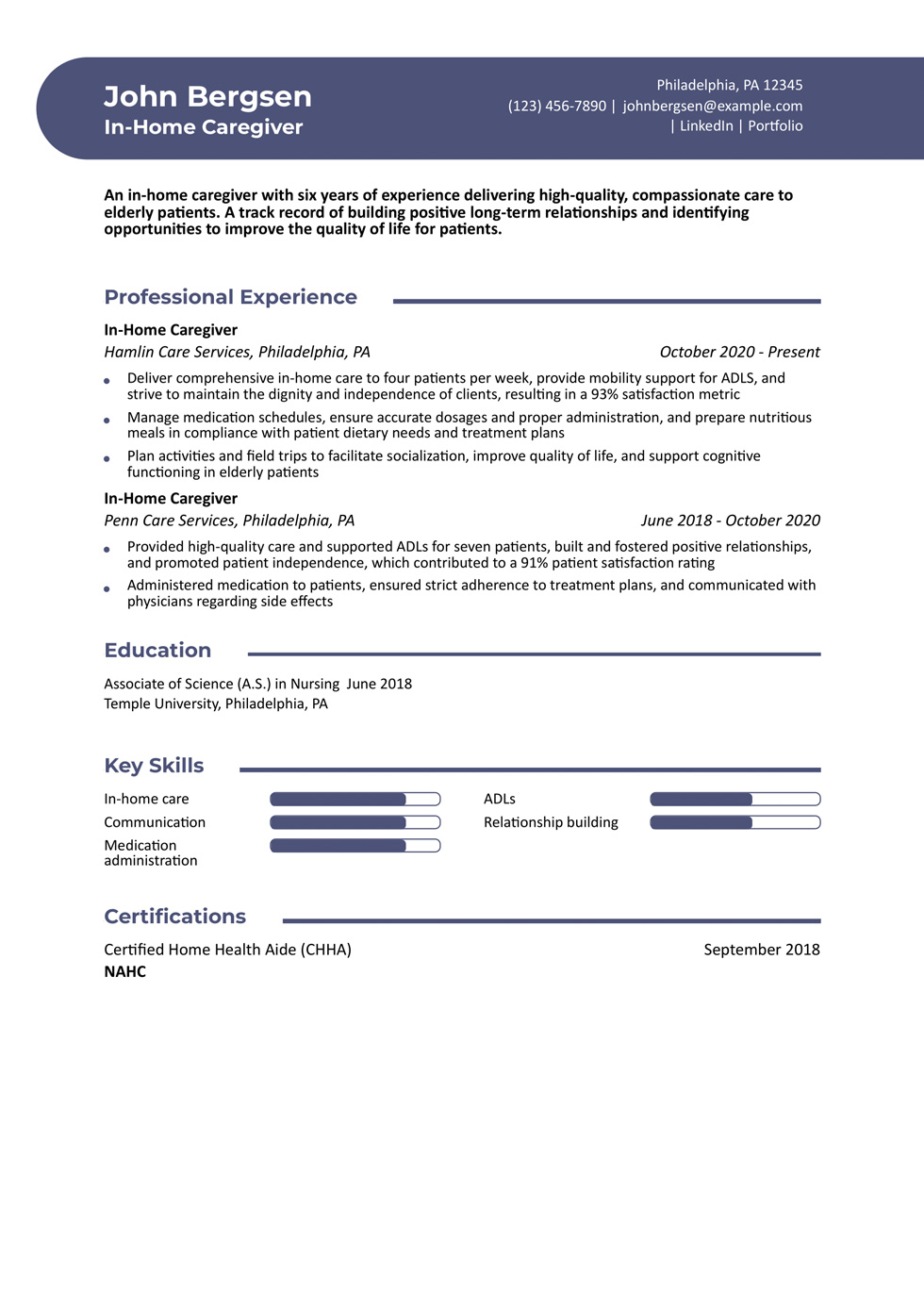
Home Health Caregiver Resume Example
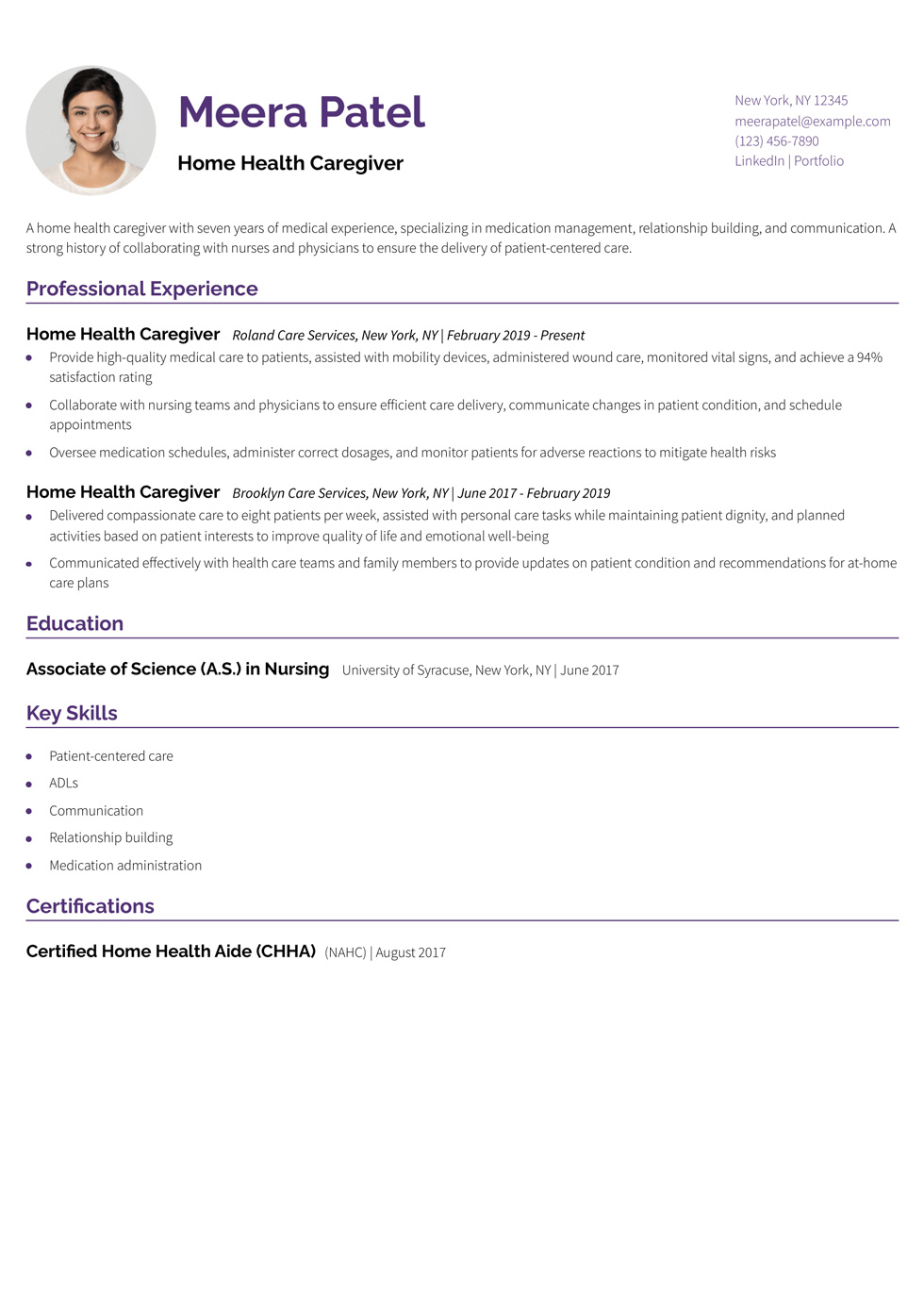
Personal Caregiver Resume Example
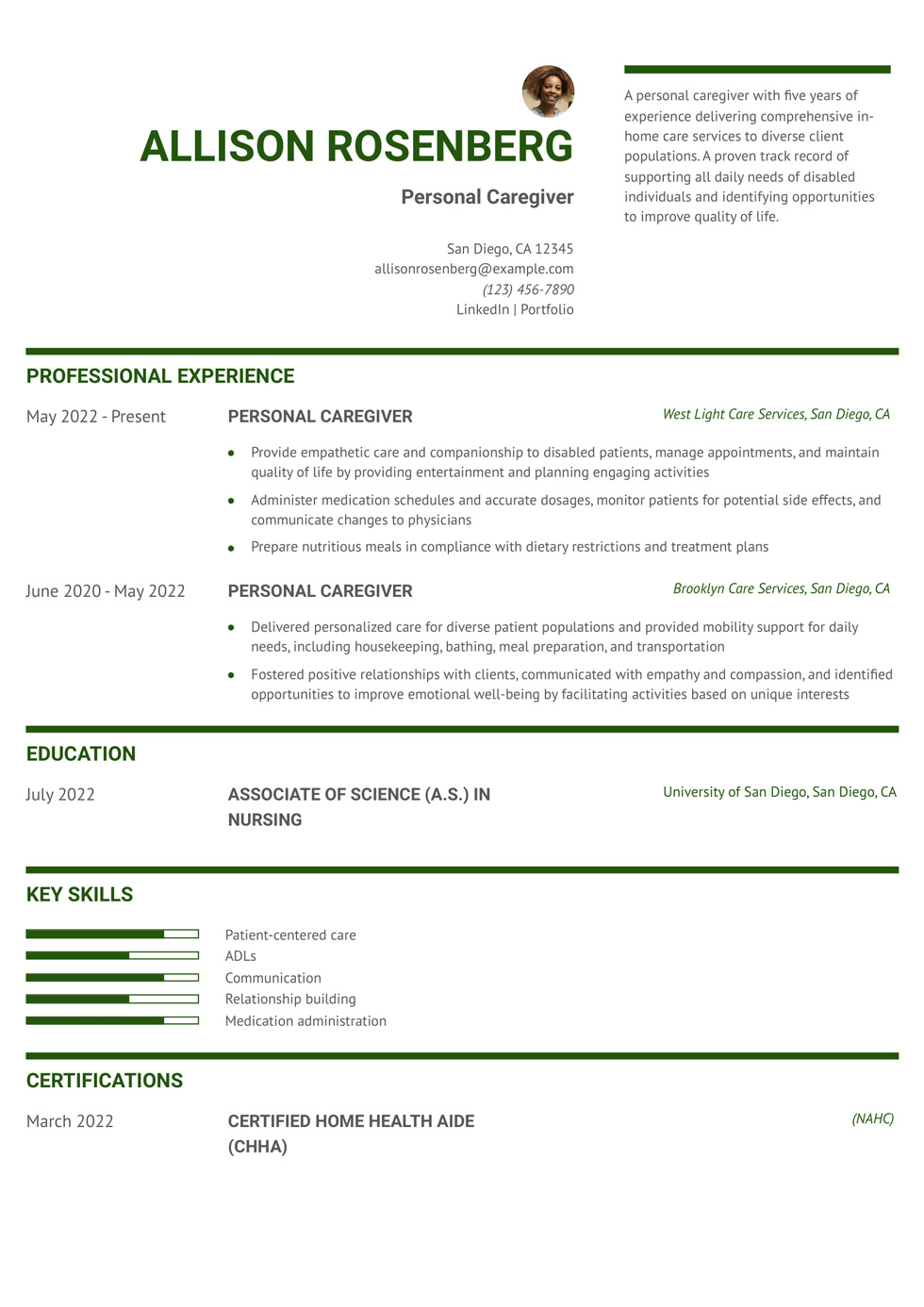
Elderly Caregiver Resume Example
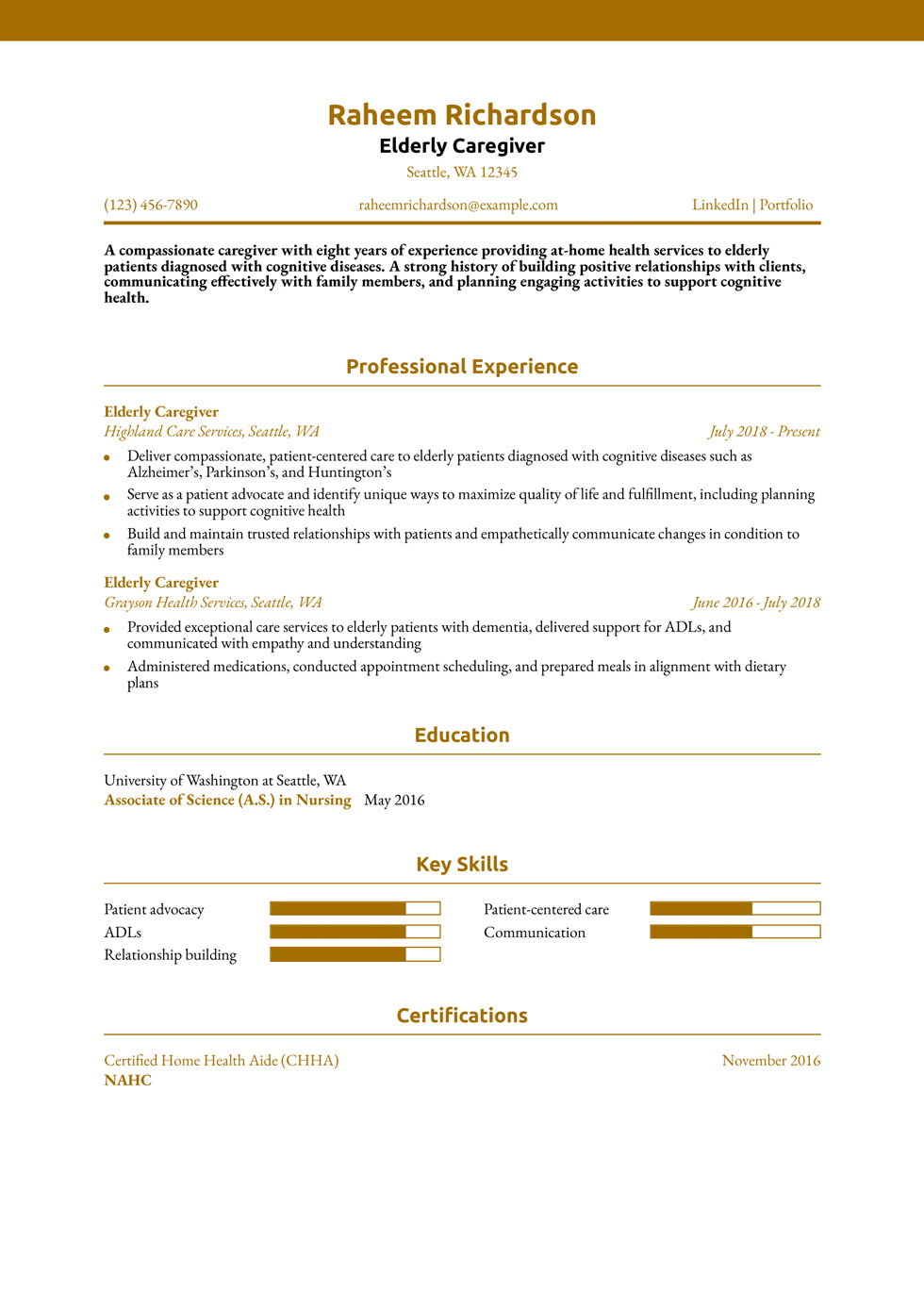
Companion Caregiver Resume Example
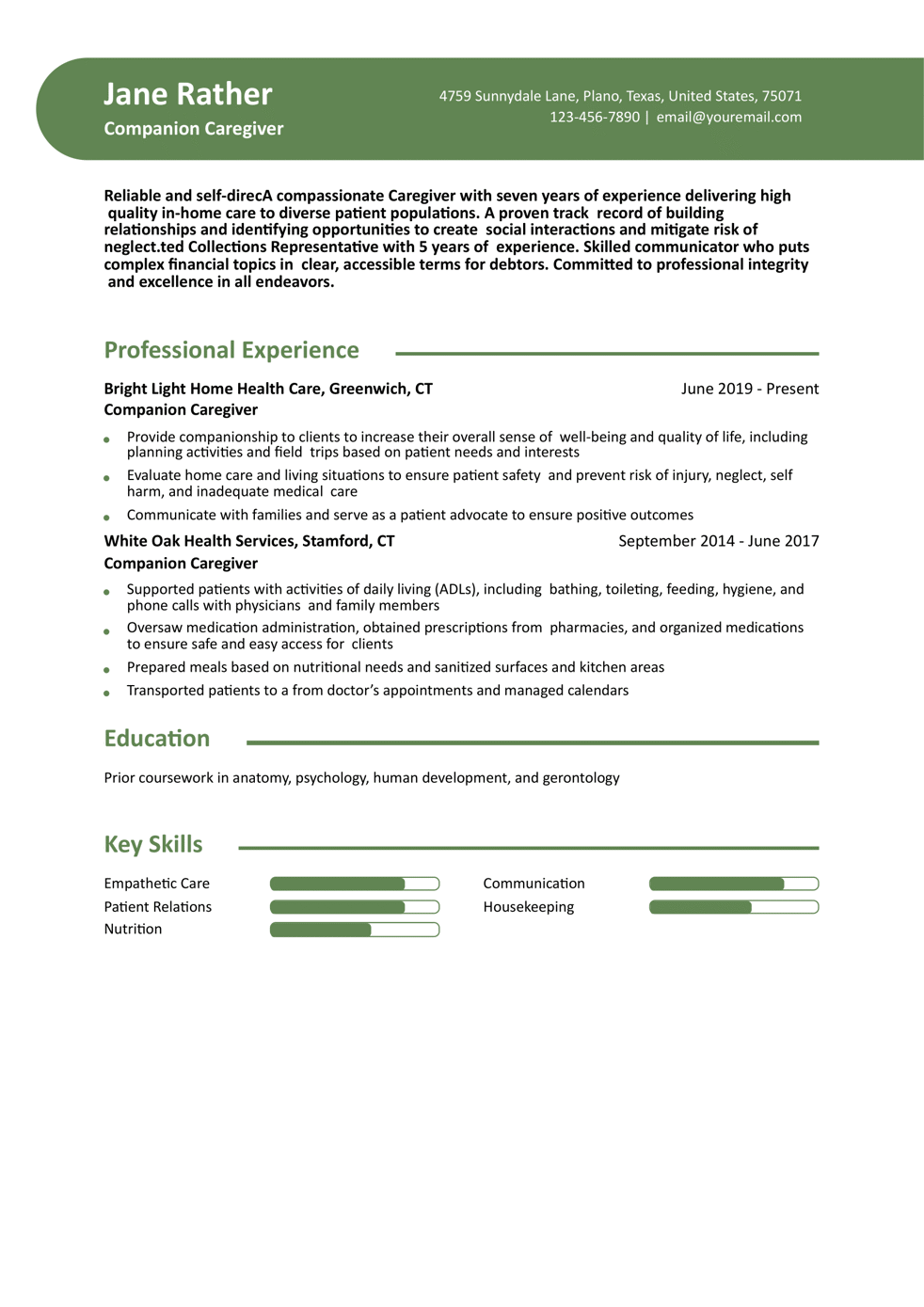
Certified Home Health Aide Resume Example
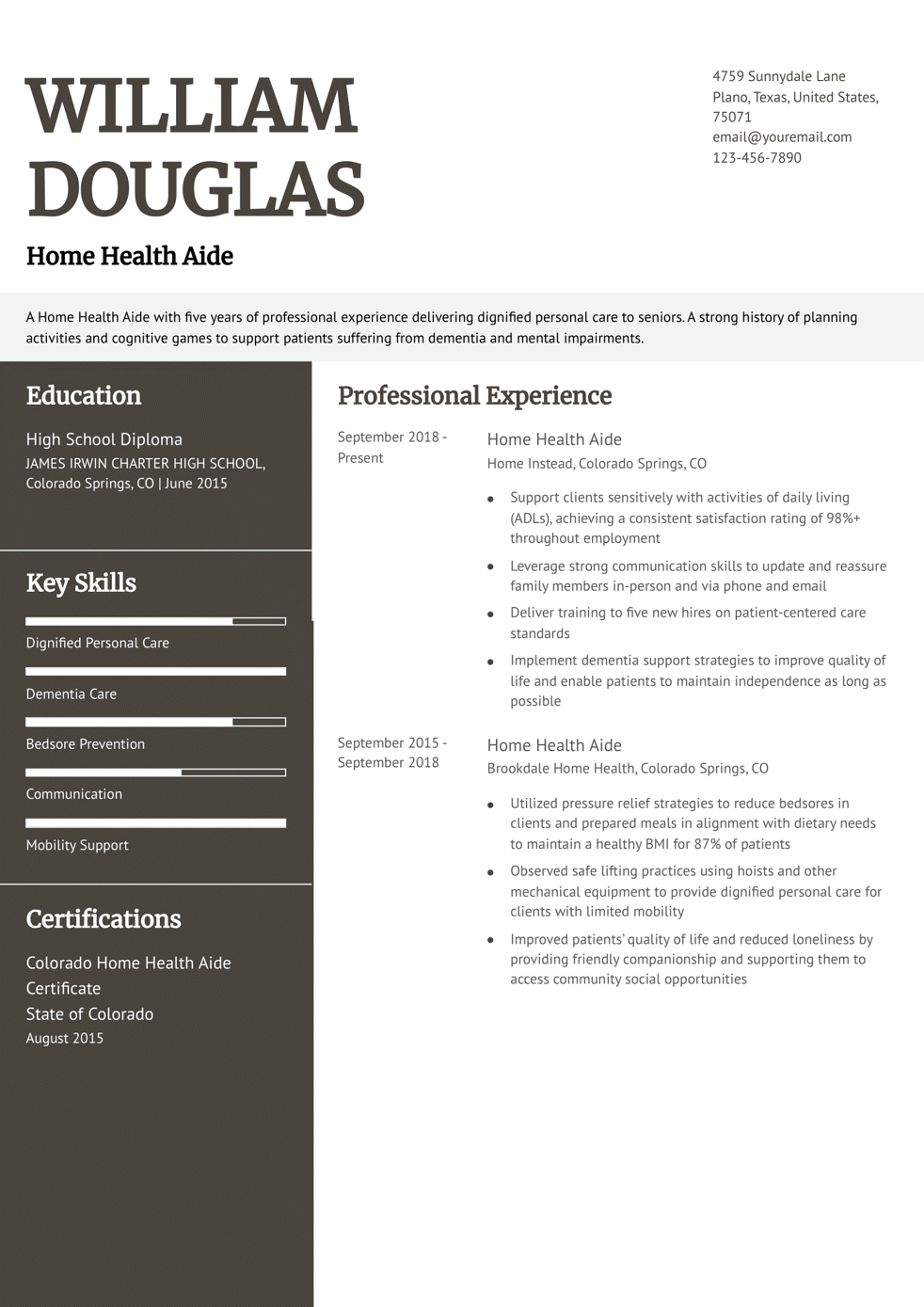
Our templates are crafted by professional resume writers to make creating your resume quick, easy, and effective.
- Professional resume template downloads
- Customized cover letter generation
- AI resume writing support
- Career-building resources and advice
Caregiver Text-Only Resume Templates and Examples
How To Write a Caregiver Resume
Caregiver resumes require a mix of essential caregiving skills and information about your personal style in the role. The work of a caregiver entails a wide range of tasks and a lot of personal involvement with their clients or patients. Follow our strategies to write a resume that captures your compassionate nature and positions you as the ideal candidate.
1. Create a profile by summarizing your caregiver qualifications
A well-crafted resume profile should instantly grab the attention of hiring managers, conveying your unique value as a caregiver and enticing recruiters to continue reading. Keep your resume profile brief, using two to three sentences to write your paragraph. Customize your profile for the position by highlighting your relevant experience, skills, and accomplishments as a caregiver.
Utilize industry-specific keywords from the job description to demonstrate your alignment with the role. Draw attention to your compassion, empathy, and dedication to providing quality care. Share your years of experience and make an impact by briefly mentioning certifications or specialized training you possess, such as CPR or first aid.
Senior-Level Profile Example
Compassionate caregiver with over 12 years of experience engaging seniors living at home to improve activity levels and general wellness. Skilled at housekeeping and cooking. A proven track record of creating healthy and positive home atmospheres.
Entry-Level Profile Example
A professional caregiver with two years of experience in assisting with daily living activities like dressing, grooming, bathing, and meal preparation. A strong history of delivering compassionate and empathetic care to elderly clients.
2. Create a powerful list of your caregiver experiences
Use your professional experience section to show your impact in previous positions. Instead of simply listing your responsibilities, utilize bullet points to focus on the specific outcomes and results you achieved. Give the number of clients you cared for or use percentages to show improvements in client well-being under your supervision.
Emphasize instances where you successfully managed complex situations, resolved conflicts, or collaborated with health care professionals. Use action verbs to demonstrate your proactive approach as you write each bullet point. Effectively convey your capabilities by showcasing concrete achievements and using dynamic language.
Senior-Level Professional Experience Example
Professional Caregiver, Help at Home, Charlotte, NC
April 2010 – present
- Successfully managed schedules for over six patients weekly, including coordinating doctors’ visits and other errands
- Assisted many clients with the maintenance and sanitation of their homes
- Performed routine medical care and maintained medical equipment according to instructions provided by health care professionals
Entry-Level Professional Experience Example
Caregiver, Great Nursing Home, Bright Lights, NV
November 2020 – present
- Deliver medical care and support to geriatric patients, including Activities of Daily Living (ADLs) and mobility exercises
- Plan and organize a variety of entertainment activities designed to stimulate the brain and memory of residents with Alzheimer’s or other dementias
- Lead small groups in modified exercise programs developed by the staff physical therapist, including chair yoga
3. Add caregiver education and certifications
As you fill out the education section of your caregiver resume, only include relevant training and coursework. Present your educational achievements and showcase your qualifications to enhance your credibility as a caregiver. List any degrees or diplomas you’ve earned, starting with your highest level of education. Specify the degree name, school name, location, and completion date.
Dedicate a separate section displaying certifications or other qualifications essential for caregiving roles, such as CPR, first aid, or specialized training in specific medical conditions. Format this section similarly, providing the certification name, the issuing organization, and the date received.
Education
Template
- [Degree Name]
- [School Name], [City, State Abbreviation] [Dates Enrolled]
Example
- High School Diploma, 3.81 GPA
- Senior High School, Costa Mesa, CA, August 2006 – June 2010
Certifications
Template
- [Certification Name], [Awarding Organization], [Completion Year]
Example
- National Emergency Medical Technician Certification, NREMT, Certified 2011, License status: Current
4. List key caregiver skills and proficiencies
Including a skills section in your caregiver resume allows you to highlight the specific abilities that make you a qualified candidate. Caregiving roles require diverse skills, and hiring managers are looking for candidates with particular competencies. Use this section to demonstrate your expertise and proficiency in the most relevant areas related to the job in question. Review this list of skills to get a good idea of what employers may be looking for:
| Key Skills and Proficiencies | |
|---|---|
| ADLs | Electronic medical records (EHR) |
| Empathetic care | Feeding |
| Health and safety | HIPAA |
| Home health care | Interpersonal communication |
| Medical care | Medication administration |
| Nursing care | Patient communication |
| Patient management | Patient transport |
| Physical examinations | Physical therapy |
| Relationship building | Vital sign monitoring |
| Wound care | |
How To Pick the Best Caregiver Resume Template
Before you start typing up your resume, choose a template to lay a solid foundation for your writing. The best resume template for a caregiver is clean, organized, and highlights your most relevant professional accomplishments. Opt for a template that allows easy readability, with clear section headings and ample white space. Consider the expectations of the industry when making your choice. Avoid overly decorative designs that could distract readers from what’s most important. Your resume should reflect your unique personality but maintain a professional, polished look.
Frequently Asked Questions: Caregiver Resume Examples and Advice
What should I avoid when writing my Caregiver CV to ensure it's professional and impactful?-
To ensure your Caregiver CV stands out, avoid using generic terms or vague language. Focus on specific achievements with numbers and data that demonstrate your real-world impact. Also, be cautious of overloading the document with too much text or irrelevant information—keep it focused on your most relevant skills and experience.
What are common action verbs for caregiver resumes?-
Writing your professional experience section can sometimes feel overwhelming, especially when finding the right words to describe your responsibilities and achievements. To help you overcome this challenge, we compiled a list of common action verbs. These verbs will invigorate your resume and demonstrate your valuable skills. Consider using some of these words in your caregiver resume:
| Action Verbs | |
|---|---|
| Analyzed | Assisted |
| Communicated | Conducted |
| Coordinated | Created |
| Delivered | Drove |
| Enhanced | Executed |
| Identified | Implemented |
| Improved | Interfaced |
| Managed | Monitored |
| Oversaw | Performed |
| Resolved | Supported |
How do you align your resume with a job description?-
The home health and personal care aide industry will experience explosive growth over the next decade. This industry is expected to add nearly 1 million new jobs by 2031, growing at a much faster-than-average rate of 25%. With this extreme increase in demand, caregivers will be navigating a competitive job market and need their resumes to stand out.
If you have a specific job opening in mind, it is highly recommended that you tailor your resume specifically to the position. Emphasize skills you know the employer is looking for and use language that mirrors terminology used in the job description. Present yourself as the perfect match.
What is the best caregiver resume format?-
The chronological format is often the best choice for caregiver resumes. This format allows you to present your work experience in reverse chronological order, emphasizing your continuity of employment and demonstrating dedication to your work. However, there may be situations where a functional or combination format is more appropriate. The functional format can be helpful if you have limited work experience or are transitioning into caregiving from another field, as it focuses on skills over employment history. Combination resumes are a healthy mixture of both and are useful for small career jumps to a similar position. The format of your resume should be selected based on your specific needs.
What’s the recommended length for a caregiver resume?-
The recommended length for a caregiver resume is one page, especially for professionals with under 10 years of experience. A two-page resume can work for those with substantial accomplishments or a longer career, but only if it’s concise and highly relevant to the role. Tailoring your resume to the job and highlighting your strongest qualifications are key to success.
Stick to listing work experience from the last 10 to 15 years, as this period is most relevant to employers. Summarize or omit older positions unless they’re crucial for your application. A focused and streamlined resume will help capture the hiring manager’s attention.

A well-crafted cover letter will enhance your chances of securing an interview in your job search. Research the company and position you’re applying for to customize your letter and make a solid first impression. Learn how to write your own caregiver cover letter with our comprehensive cover letter guide. For more cover letter examples in related occupations, check out our guides for healthcare professionals and certified nursing assistants.
Craft your perfect resume in minutes
Get 2x more interviews with Resume Builder. Access Pro Plan features for a limited time!
